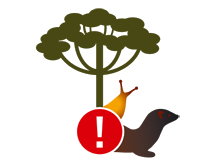Japanese knotweed – Reynoutria japonica
- Overview
- Images
- Identify
- Biology
- Taxonomy
- Occurrence
- Specimen
- Invasive alien species

Finland’s National Strategy on Invasive Alien Species (GR 2012) ? Government Decree on Managing the Risk Caused by Alien Species (704/2019, VN 912/2023) ?
Classification
Invasive alien species included in the national list (National list of alien species)
Japanese knotweed is included in the national list of invasive alien species. Invasive alien species may not be released into the wild, imported into Finland from outside the EU or from other EU countries, transported, transferred, bred or cultivated, disposed of, passed on, sold, marketed, or otherwise handed over.
Harmfulness
Tall knotweeds are strong competitors and there are few other species that can grow in the stands they form. They spread well vegetatively and compete with synanthropes in the vicinity of inhabited areas. Knotweeds also occur to some extent in protected areas, e.g., groves, and in the vicinity of endangered forest, meadow and limestone rock species.
In dense knotweed stands, the growing conditions change completely and, for example, the seeds of woody perennials cannot germinate and the natural development of vegetation in the area slows down or alters completely. Especially in bright sites, Japanese knotweed can form a completely dominant vegetation, while in shady sites it is a slightly weaker competitor to other plants.
Along rivers and streams, knotweed vegetation can increase erosion and soil drift into waterways, as the vegetation completely withers during the winter and does not bind the soil during winter and spring rainfall. The diversion of loose soil into waterways can pose a threat e.g. to spawning grounds for trout.
According to the DAISIE database funded by the European Commission, Fallopia japonica is included in the list of 100 worst invasive alien species in Europe. It has been classified as an invasive alien species even in Estonia, Sweden, Norway and Denmark. The spread of the plant into the wild was prohibited in the United Kingdom in 1981.
Prevention methods
Knotweeds have proven to be extremely difficult to eradicate. Mere weeding or cutting of stems is not enough, as knotweeds easily generate new growth. It is usually impossible to eradicate knotweeds by digging them out, because they create new growth from the tiniest rhizome fragments remaining in the soil. Eradication of small-scale stands may succeed if the stand is first cut down completely and then covered with black plastic for 3 to 4 years. The following method has proven successful in controlling knotweed stands: the stems are cut close to the base and pesticide is sprayed into the hollow stems. This is repeated a few times per year until the stand vanishes. The cut stems can be left to decompose on top of the stand.
An alternative method of controlling large-scale stands is to bring sheep to graze in the area. In this case, it is important to remove all dry Japanese knotweed stems from the previous year, because they are razor sharp for grazing animals.
Pesticides may have to be used in tricky sites. These may not be used at all in groundwater areas, or in the vicinity of wells or surface water, or close to children’s playgrounds. New emerging shoots can be removed by pulling them up manually. They are then disposed of by burning or composting.
What can I do?
Because the species is legislated as a nationally invasive alien species, its import, breeding, sale and other possession as well as release into the environment is prohibited.
Do not buy or breed the invasive alien species. Also, it is prohibited to order a Japanese knotweed from online stores. The species must not be passed on. Eradicate invasive alien species from your garden and treat garden waste so that germinating seeds or plant parts cannot survive. Make sure that the species does not spread with the soil either. In your own garden, it is worth to prefer domestic or poorly spreading plants.
Professional operators have the duty to prevent Japanese knotweeds, as well as its seeds and plant parts, from spreading outside the area under their control for example in compost, soil and other plants.